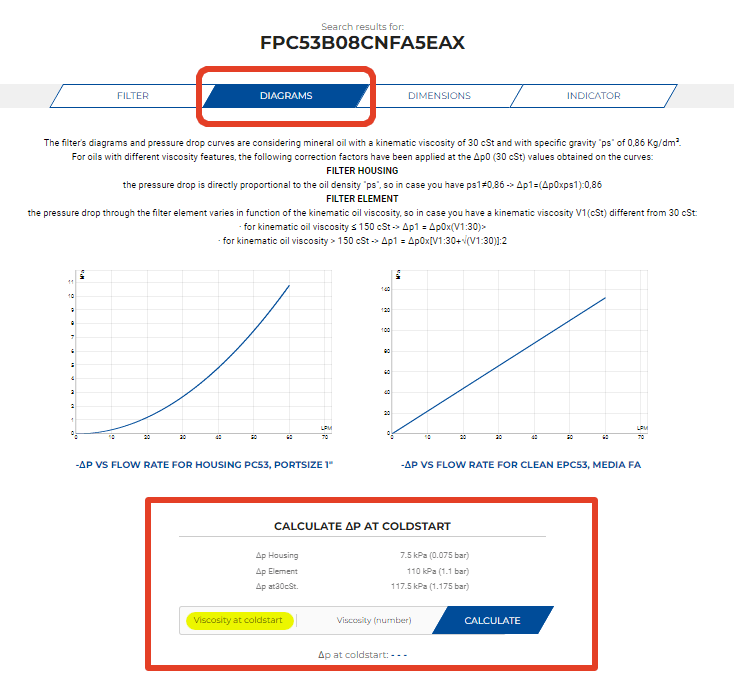
This month we continue our journey into the world of pressure drops, this time focusing on pressure drops under cold start and discovering how to solve this problem.
In response to the ever-increasing market demand for higher performance, filter experts, such as UFI Filter Hydraulics, have to identify the best compromise between key competing factors such as pressure drop, filtration efficiency and dirt-hold capacity, especially in specific operating conditions or environments, such as during cold start-ups.
What are the main problems connected with cold start-ups?
Typically, the problems associated with cold start-ups include the filter differential pressure exceeding the expected limit, in this case mainly because of the higher oil viscosity at low temperatures.
This causes the filter to go into bypass mode, allowing unfiltered oil to pass through the system, until the fluid temperature increases, bringing the pressure drop back to the expected level. Once the working temperature is reached, the bypass closes and the filter starts filtering the oil properly again.
If the system has a very short warm-up period, and there are no critical components, it may be worth considering allowing the filter to go into bypass mode for a short period.
However, for critical systems with a long warm-up period, the filter must be selected based on the worst-case viscosity and working conditions.
This prevents the pressure drop from reaching the opening pressure of the bypass valve. This will result in a larger filter than the one sized considering the operating conditions of the system, i.e. with fluid at temperature and reduced viscosity. A further advantage of a filter sized for cold start is the longer life of the element, which will therefore require less maintenance and less frequent replacement.
Calculation of the pressure drop under cold start or high viscosity conditions
As explained in last month’s post, pressure drops are directly proportional to the viscosity of the fluid; therefore, higher oil viscosity corresponds to greater pressure drops inside the filter, and vice versa (as the viscosity of the oil decreases, the pressure drops become smaller).
The viscosity of a fluid depends on the fluid’s temperature and affects the performance of the fluid and hydraulic system.
To correctly calculate the pressure drop in the case of high viscosity, such as during cold starts, we need to consider the density change due to the temperature.
According to the formula for ∆p that we saw in last month’s post, the total pressure drop of the filter is calculated by summing the pressure drops of the filter body and filter element.
For the filter body:
 where:
where:
- 86 Kg/dm3 = density at room temperature (20°C)
- ∆p0 = pressure drop at room temperature
- ∆p1 = pressure drop at operating temperature
- ρ1 = density at operating temperature, which can be calculated using equation (1):
![]() where:
where:
- ρT = density at temperature T
- ∆T = temperature change from room temperature (20°C)
- k = volumetric thermal expansion coefficient
For the filter element, the pressure drop varies with the kinematic viscosity of the oil, so for kinematic viscosity V1 (cSt) ≠ 30 cSt:
- If the kinematic oil viscosity V1 is ≤150 cSt, Δp1= Δp0 × (V1/30)
- If the kinematic oil viscosity V1 is >150 cSt, Δp1= Δp0 × [V1/30 + √(V1/30)]/2
As we are considering temperature changes, we must remember that these will affect the kinematic viscosity. The kinematic viscosity can be expressed as

where:
- η = dynamic viscosity
- ρ = density
Thus, for any temperature change, a new density can be calculated using equation (1).
Verification of pressure drop during cold start using a software tool
Some hydraulic filtration experts provide a software tool, such as the CAF Computer Aided Filter selector by UFI Filters Hydraulics, that can generate a quick and accurate indication of the pressure drop for a specific application, based on operating characteristics selected directly from the configurator.
In particular, the UFI Filters Hydraulics tool allows verification of the performance of a single filter under standard conditions, with the possibility of choosing from among the most common viscosity values for the hydraulic fluid (22, 30, 46 and 68 cSt).
Once the pressure drop under standard conditions has been verified, the user can calculate the pressure drop under cold-start conditions by selecting the DIAGRAM tab for the selected product, as shown in the following screenshot:

To evaluate the pressure drop under cold-start conditions, the CAF Computer Aided Filter selector from UFI Filters Hydraulics relies on experimental tests, which are essential for low-temperature operating conditions, carried out at UFI Group’s well-equipped laboratories.
For any further information, please contact our Sales team or use CAF to check for yourself the pressure drop of your system, 24 hours a day, 7 days a week.